Financial Ratio Analysis of Walmart: Fundamentals of Management
VerifiedAdded on 2023/06/15
|6
|1346
|310
Report
AI Summary
This report provides a financial analysis of Walmart through ratio analysis, evaluating its financial position based on its 2016-2017 financial statements. The analysis covers liquidity ratios (current and quick ratios), profitability ratios (operating profit margin, net profit margin, return on capital employed, return on equity, return on total assets, and basic earning power), asset management ratios (inventory turnover ratio and asset turnover ratio), and debt management ratios (debt-equity ratio and interest coverage ratio). The interpretation of these ratios reveals insights into Walmart's ability to manage its assets, debts, and profitability. While sales increased, net profit decreased, and profitability ratios remained relatively stable, indicating average performance. The analysis concludes that ratio analysis is a crucial tool for assessing a company's financial health and efficiency.

Running Head: FUNDAMENTALS OF FINANCIAL MANAGEMENT
Ratio analysis
Ratio analysis
Paraphrase This Document
Need a fresh take? Get an instant paraphrase of this document with our AI Paraphraser
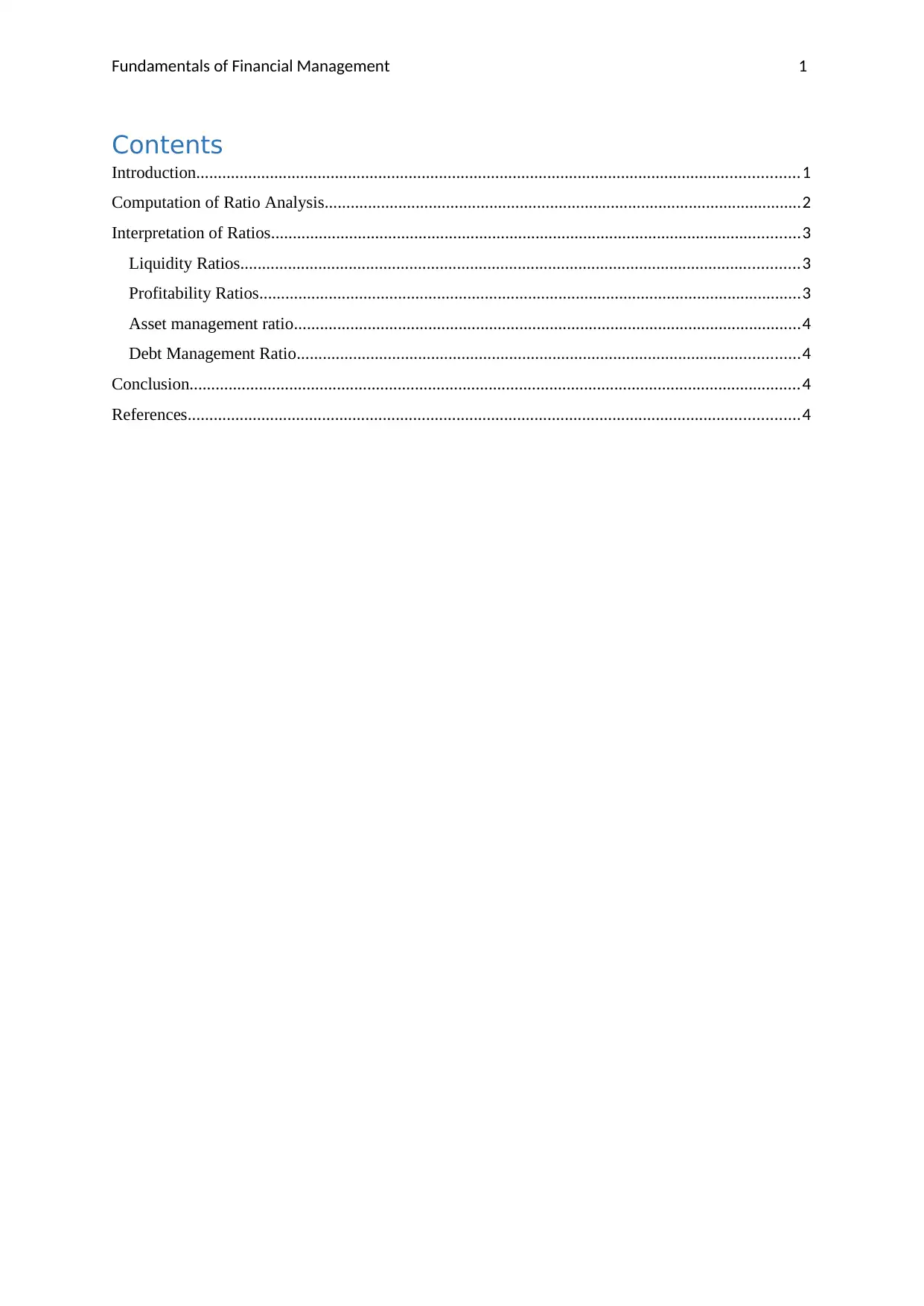
Fundamentals of Financial Management 1
Contents
Introduction...........................................................................................................................................1
Computation of Ratio Analysis..............................................................................................................2
Interpretation of Ratios..........................................................................................................................3
Liquidity Ratios.................................................................................................................................3
Profitability Ratios.............................................................................................................................3
Asset management ratio.....................................................................................................................4
Debt Management Ratio....................................................................................................................4
Conclusion.............................................................................................................................................4
References.............................................................................................................................................4
Contents
Introduction...........................................................................................................................................1
Computation of Ratio Analysis..............................................................................................................2
Interpretation of Ratios..........................................................................................................................3
Liquidity Ratios.................................................................................................................................3
Profitability Ratios.............................................................................................................................3
Asset management ratio.....................................................................................................................4
Debt Management Ratio....................................................................................................................4
Conclusion.............................................................................................................................................4
References.............................................................................................................................................4
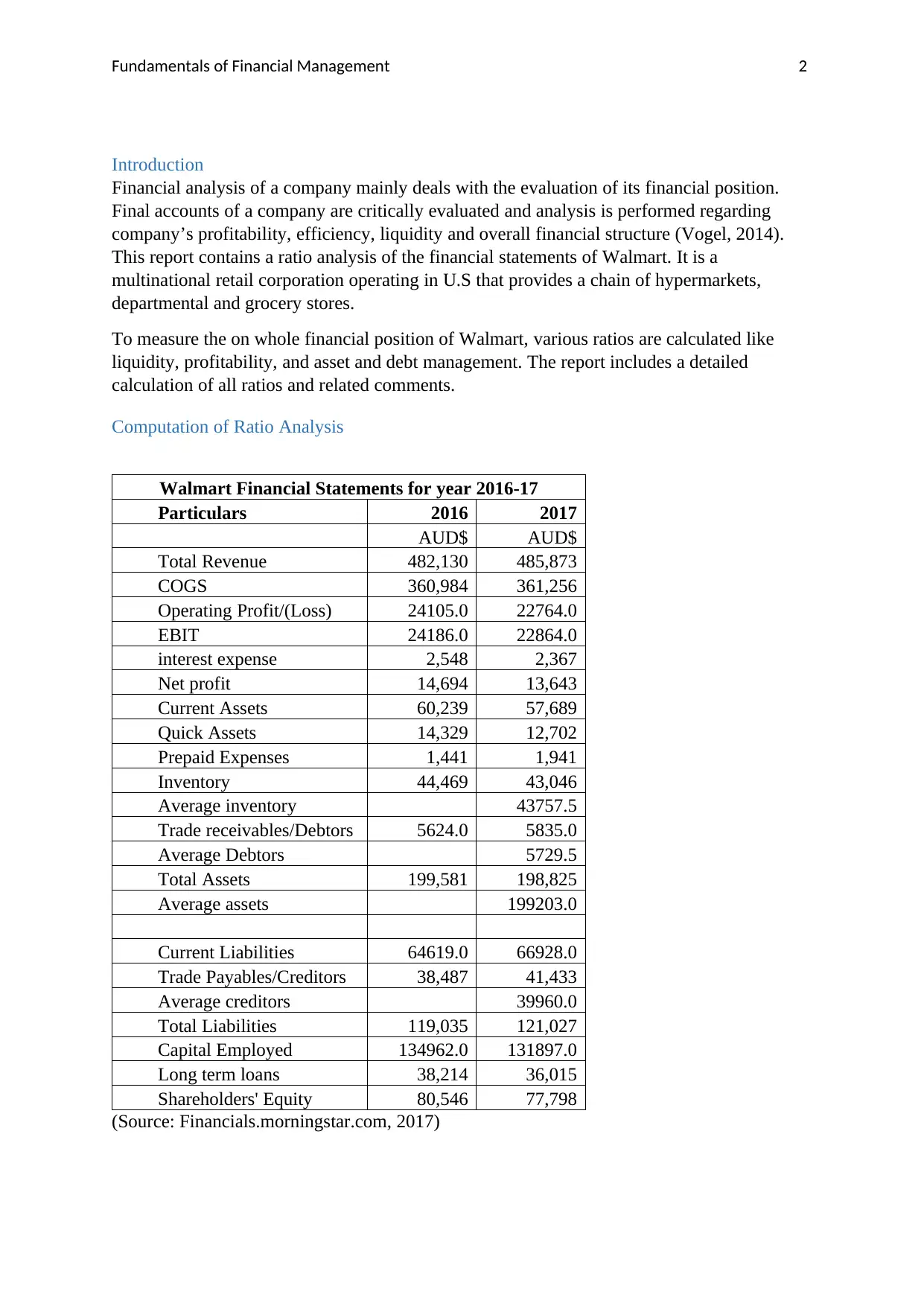
Fundamentals of Financial Management 2
Introduction
Financial analysis of a company mainly deals with the evaluation of its financial position.
Final accounts of a company are critically evaluated and analysis is performed regarding
company’s profitability, efficiency, liquidity and overall financial structure (Vogel, 2014).
This report contains a ratio analysis of the financial statements of Walmart. It is a
multinational retail corporation operating in U.S that provides a chain of hypermarkets,
departmental and grocery stores.
To measure the on whole financial position of Walmart, various ratios are calculated like
liquidity, profitability, and asset and debt management. The report includes a detailed
calculation of all ratios and related comments.
Computation of Ratio Analysis
Walmart Financial Statements for year 2016-17
Particulars 2016 2017
AUD$ AUD$
Total Revenue 482,130 485,873
COGS 360,984 361,256
Operating Profit/(Loss) 24105.0 22764.0
EBIT 24186.0 22864.0
interest expense 2,548 2,367
Net profit 14,694 13,643
Current Assets 60,239 57,689
Quick Assets 14,329 12,702
Prepaid Expenses 1,441 1,941
Inventory 44,469 43,046
Average inventory 43757.5
Trade receivables/Debtors 5624.0 5835.0
Average Debtors 5729.5
Total Assets 199,581 198,825
Average assets 199203.0
Current Liabilities 64619.0 66928.0
Trade Payables/Creditors 38,487 41,433
Average creditors 39960.0
Total Liabilities 119,035 121,027
Capital Employed 134962.0 131897.0
Long term loans 38,214 36,015
Shareholders' Equity 80,546 77,798
(Source: Financials.morningstar.com, 2017)
Introduction
Financial analysis of a company mainly deals with the evaluation of its financial position.
Final accounts of a company are critically evaluated and analysis is performed regarding
company’s profitability, efficiency, liquidity and overall financial structure (Vogel, 2014).
This report contains a ratio analysis of the financial statements of Walmart. It is a
multinational retail corporation operating in U.S that provides a chain of hypermarkets,
departmental and grocery stores.
To measure the on whole financial position of Walmart, various ratios are calculated like
liquidity, profitability, and asset and debt management. The report includes a detailed
calculation of all ratios and related comments.
Computation of Ratio Analysis
Walmart Financial Statements for year 2016-17
Particulars 2016 2017
AUD$ AUD$
Total Revenue 482,130 485,873
COGS 360,984 361,256
Operating Profit/(Loss) 24105.0 22764.0
EBIT 24186.0 22864.0
interest expense 2,548 2,367
Net profit 14,694 13,643
Current Assets 60,239 57,689
Quick Assets 14,329 12,702
Prepaid Expenses 1,441 1,941
Inventory 44,469 43,046
Average inventory 43757.5
Trade receivables/Debtors 5624.0 5835.0
Average Debtors 5729.5
Total Assets 199,581 198,825
Average assets 199203.0
Current Liabilities 64619.0 66928.0
Trade Payables/Creditors 38,487 41,433
Average creditors 39960.0
Total Liabilities 119,035 121,027
Capital Employed 134962.0 131897.0
Long term loans 38,214 36,015
Shareholders' Equity 80,546 77,798
(Source: Financials.morningstar.com, 2017)
⊘ This is a preview!⊘
Do you want full access?
Subscribe today to unlock all pages.

Trusted by 1+ million students worldwide
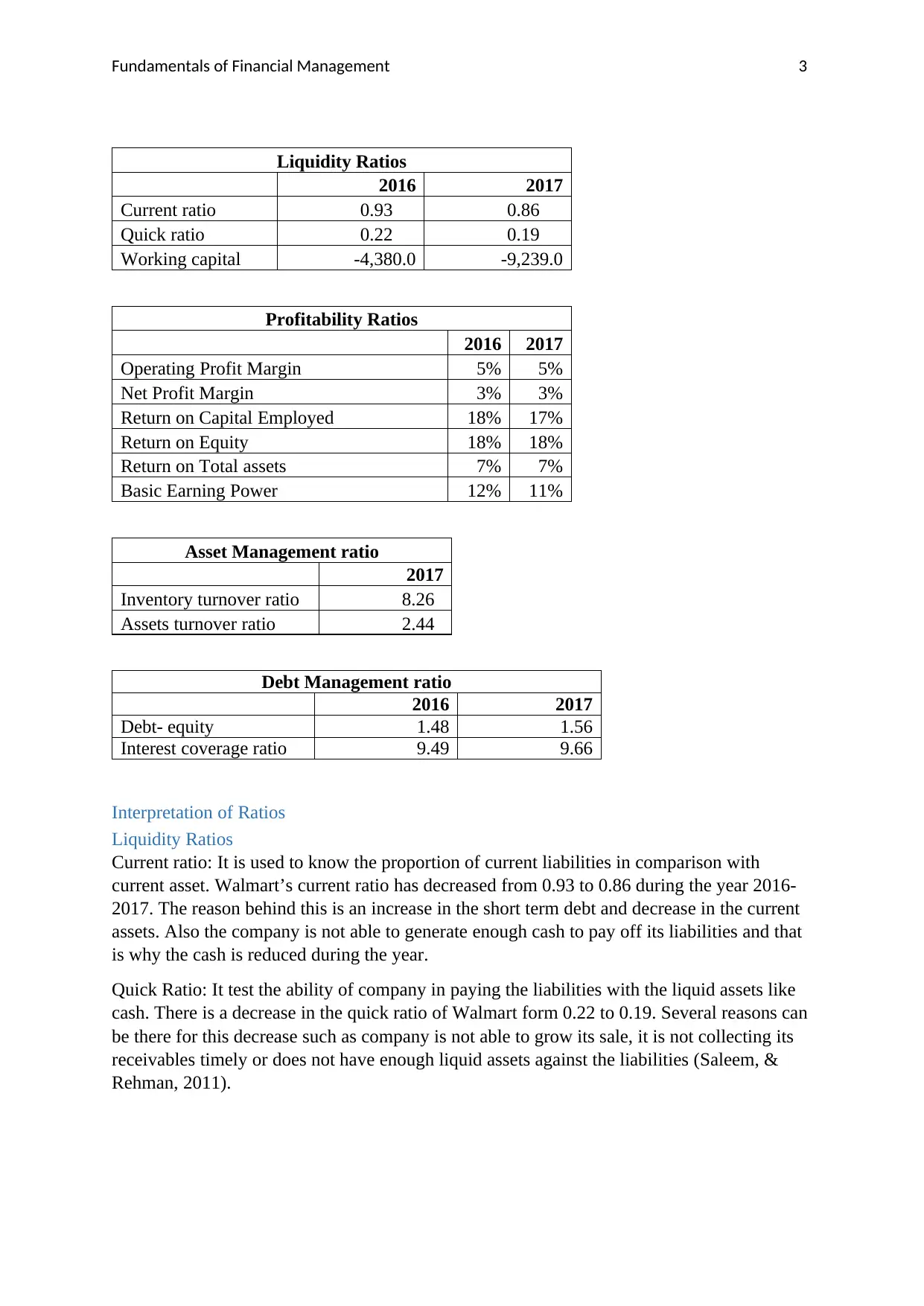
Fundamentals of Financial Management 3
Liquidity Ratios
2016 2017
Current ratio 0.93 0.86
Quick ratio 0.22 0.19
Working capital -4,380.0 -9,239.0
Profitability Ratios
2016 2017
Operating Profit Margin 5% 5%
Net Profit Margin 3% 3%
Return on Capital Employed 18% 17%
Return on Equity 18% 18%
Return on Total assets 7% 7%
Basic Earning Power 12% 11%
Asset Management ratio
2017
Inventory turnover ratio 8.26
Assets turnover ratio 2.44
Debt Management ratio
2016 2017
Debt- equity 1.48 1.56
Interest coverage ratio 9.49 9.66
Interpretation of Ratios
Liquidity Ratios
Current ratio: It is used to know the proportion of current liabilities in comparison with
current asset. Walmart’s current ratio has decreased from 0.93 to 0.86 during the year 2016-
2017. The reason behind this is an increase in the short term debt and decrease in the current
assets. Also the company is not able to generate enough cash to pay off its liabilities and that
is why the cash is reduced during the year.
Quick Ratio: It test the ability of company in paying the liabilities with the liquid assets like
cash. There is a decrease in the quick ratio of Walmart form 0.22 to 0.19. Several reasons can
be there for this decrease such as company is not able to grow its sale, it is not collecting its
receivables timely or does not have enough liquid assets against the liabilities (Saleem, &
Rehman, 2011).
Liquidity Ratios
2016 2017
Current ratio 0.93 0.86
Quick ratio 0.22 0.19
Working capital -4,380.0 -9,239.0
Profitability Ratios
2016 2017
Operating Profit Margin 5% 5%
Net Profit Margin 3% 3%
Return on Capital Employed 18% 17%
Return on Equity 18% 18%
Return on Total assets 7% 7%
Basic Earning Power 12% 11%
Asset Management ratio
2017
Inventory turnover ratio 8.26
Assets turnover ratio 2.44
Debt Management ratio
2016 2017
Debt- equity 1.48 1.56
Interest coverage ratio 9.49 9.66
Interpretation of Ratios
Liquidity Ratios
Current ratio: It is used to know the proportion of current liabilities in comparison with
current asset. Walmart’s current ratio has decreased from 0.93 to 0.86 during the year 2016-
2017. The reason behind this is an increase in the short term debt and decrease in the current
assets. Also the company is not able to generate enough cash to pay off its liabilities and that
is why the cash is reduced during the year.
Quick Ratio: It test the ability of company in paying the liabilities with the liquid assets like
cash. There is a decrease in the quick ratio of Walmart form 0.22 to 0.19. Several reasons can
be there for this decrease such as company is not able to grow its sale, it is not collecting its
receivables timely or does not have enough liquid assets against the liabilities (Saleem, &
Rehman, 2011).
Paraphrase This Document
Need a fresh take? Get an instant paraphrase of this document with our AI Paraphraser
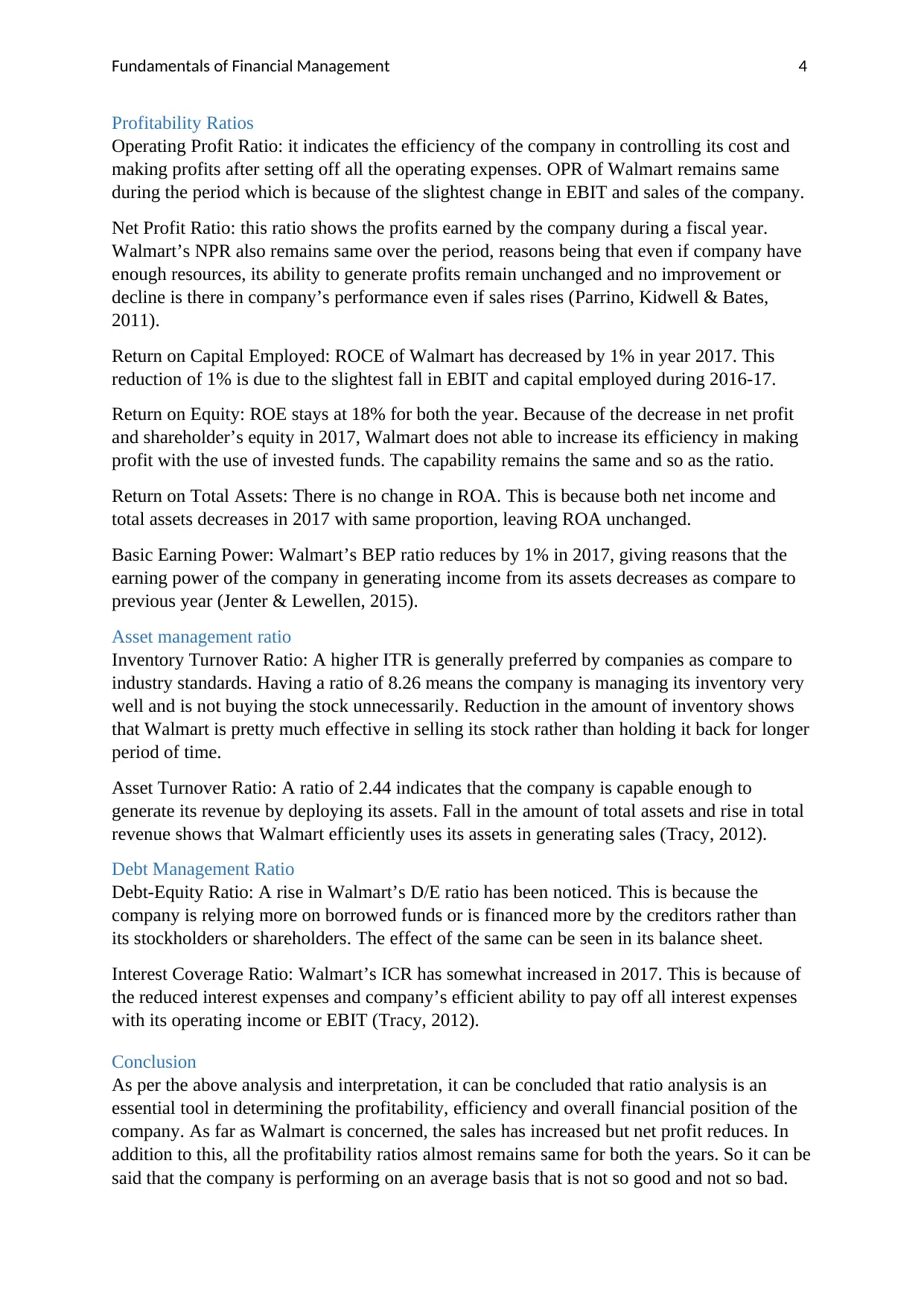
Fundamentals of Financial Management 4
Profitability Ratios
Operating Profit Ratio: it indicates the efficiency of the company in controlling its cost and
making profits after setting off all the operating expenses. OPR of Walmart remains same
during the period which is because of the slightest change in EBIT and sales of the company.
Net Profit Ratio: this ratio shows the profits earned by the company during a fiscal year.
Walmart’s NPR also remains same over the period, reasons being that even if company have
enough resources, its ability to generate profits remain unchanged and no improvement or
decline is there in company’s performance even if sales rises (Parrino, Kidwell & Bates,
2011).
Return on Capital Employed: ROCE of Walmart has decreased by 1% in year 2017. This
reduction of 1% is due to the slightest fall in EBIT and capital employed during 2016-17.
Return on Equity: ROE stays at 18% for both the year. Because of the decrease in net profit
and shareholder’s equity in 2017, Walmart does not able to increase its efficiency in making
profit with the use of invested funds. The capability remains the same and so as the ratio.
Return on Total Assets: There is no change in ROA. This is because both net income and
total assets decreases in 2017 with same proportion, leaving ROA unchanged.
Basic Earning Power: Walmart’s BEP ratio reduces by 1% in 2017, giving reasons that the
earning power of the company in generating income from its assets decreases as compare to
previous year (Jenter & Lewellen, 2015).
Asset management ratio
Inventory Turnover Ratio: A higher ITR is generally preferred by companies as compare to
industry standards. Having a ratio of 8.26 means the company is managing its inventory very
well and is not buying the stock unnecessarily. Reduction in the amount of inventory shows
that Walmart is pretty much effective in selling its stock rather than holding it back for longer
period of time.
Asset Turnover Ratio: A ratio of 2.44 indicates that the company is capable enough to
generate its revenue by deploying its assets. Fall in the amount of total assets and rise in total
revenue shows that Walmart efficiently uses its assets in generating sales (Tracy, 2012).
Debt Management Ratio
Debt-Equity Ratio: A rise in Walmart’s D/E ratio has been noticed. This is because the
company is relying more on borrowed funds or is financed more by the creditors rather than
its stockholders or shareholders. The effect of the same can be seen in its balance sheet.
Interest Coverage Ratio: Walmart’s ICR has somewhat increased in 2017. This is because of
the reduced interest expenses and company’s efficient ability to pay off all interest expenses
with its operating income or EBIT (Tracy, 2012).
Conclusion
As per the above analysis and interpretation, it can be concluded that ratio analysis is an
essential tool in determining the profitability, efficiency and overall financial position of the
company. As far as Walmart is concerned, the sales has increased but net profit reduces. In
addition to this, all the profitability ratios almost remains same for both the years. So it can be
said that the company is performing on an average basis that is not so good and not so bad.
Profitability Ratios
Operating Profit Ratio: it indicates the efficiency of the company in controlling its cost and
making profits after setting off all the operating expenses. OPR of Walmart remains same
during the period which is because of the slightest change in EBIT and sales of the company.
Net Profit Ratio: this ratio shows the profits earned by the company during a fiscal year.
Walmart’s NPR also remains same over the period, reasons being that even if company have
enough resources, its ability to generate profits remain unchanged and no improvement or
decline is there in company’s performance even if sales rises (Parrino, Kidwell & Bates,
2011).
Return on Capital Employed: ROCE of Walmart has decreased by 1% in year 2017. This
reduction of 1% is due to the slightest fall in EBIT and capital employed during 2016-17.
Return on Equity: ROE stays at 18% for both the year. Because of the decrease in net profit
and shareholder’s equity in 2017, Walmart does not able to increase its efficiency in making
profit with the use of invested funds. The capability remains the same and so as the ratio.
Return on Total Assets: There is no change in ROA. This is because both net income and
total assets decreases in 2017 with same proportion, leaving ROA unchanged.
Basic Earning Power: Walmart’s BEP ratio reduces by 1% in 2017, giving reasons that the
earning power of the company in generating income from its assets decreases as compare to
previous year (Jenter & Lewellen, 2015).
Asset management ratio
Inventory Turnover Ratio: A higher ITR is generally preferred by companies as compare to
industry standards. Having a ratio of 8.26 means the company is managing its inventory very
well and is not buying the stock unnecessarily. Reduction in the amount of inventory shows
that Walmart is pretty much effective in selling its stock rather than holding it back for longer
period of time.
Asset Turnover Ratio: A ratio of 2.44 indicates that the company is capable enough to
generate its revenue by deploying its assets. Fall in the amount of total assets and rise in total
revenue shows that Walmart efficiently uses its assets in generating sales (Tracy, 2012).
Debt Management Ratio
Debt-Equity Ratio: A rise in Walmart’s D/E ratio has been noticed. This is because the
company is relying more on borrowed funds or is financed more by the creditors rather than
its stockholders or shareholders. The effect of the same can be seen in its balance sheet.
Interest Coverage Ratio: Walmart’s ICR has somewhat increased in 2017. This is because of
the reduced interest expenses and company’s efficient ability to pay off all interest expenses
with its operating income or EBIT (Tracy, 2012).
Conclusion
As per the above analysis and interpretation, it can be concluded that ratio analysis is an
essential tool in determining the profitability, efficiency and overall financial position of the
company. As far as Walmart is concerned, the sales has increased but net profit reduces. In
addition to this, all the profitability ratios almost remains same for both the years. So it can be
said that the company is performing on an average basis that is not so good and not so bad.
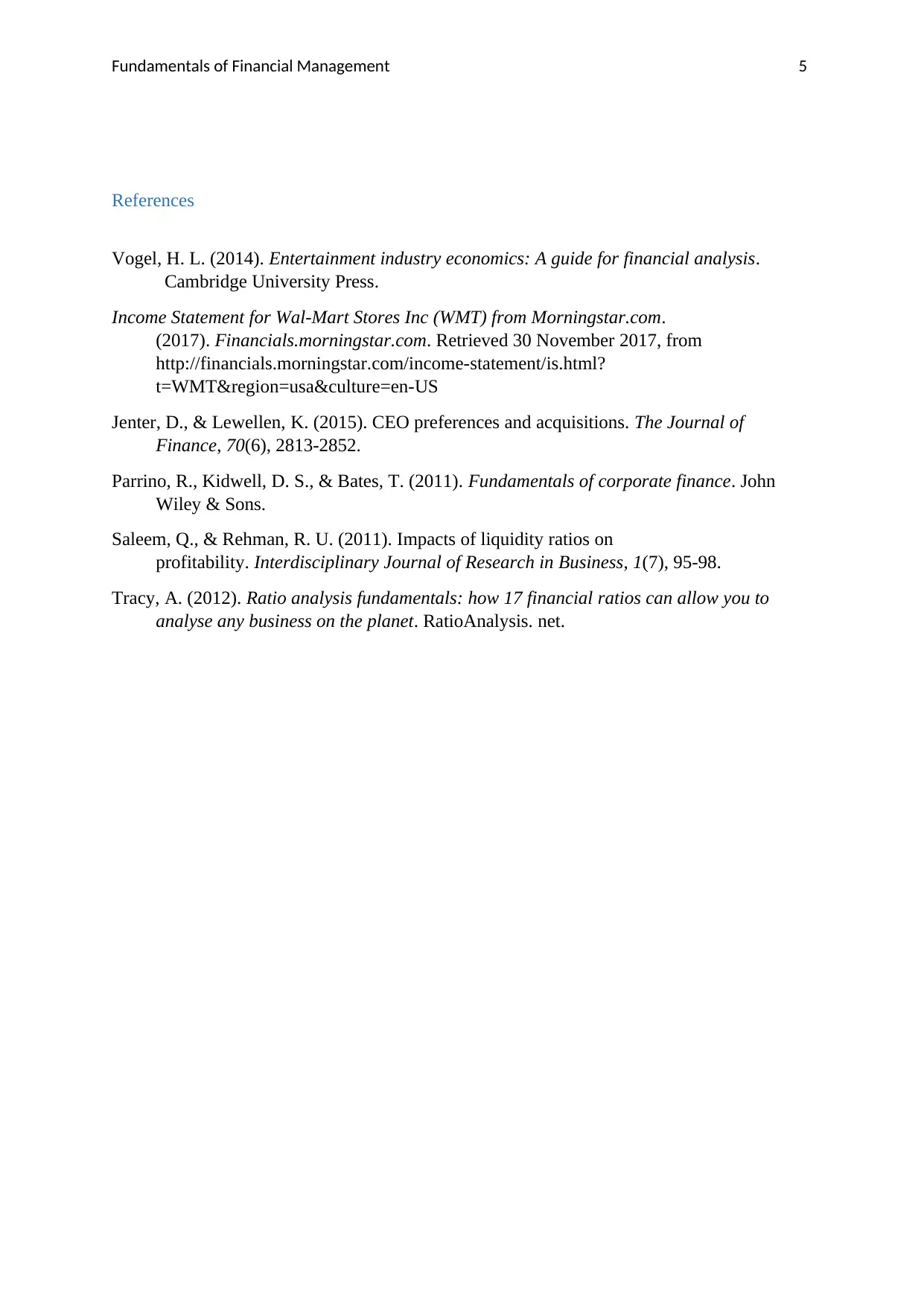
Fundamentals of Financial Management 5
References
Vogel, H. L. (2014). Entertainment industry economics: A guide for financial analysis.
Cambridge University Press.
Income Statement for Wal-Mart Stores Inc (WMT) from Morningstar.com.
(2017). Financials.morningstar.com. Retrieved 30 November 2017, from
http://financials.morningstar.com/income-statement/is.html?
t=WMT®ion=usa&culture=en-US
Jenter, D., & Lewellen, K. (2015). CEO preferences and acquisitions. The Journal of
Finance, 70(6), 2813-2852.
Parrino, R., Kidwell, D. S., & Bates, T. (2011). Fundamentals of corporate finance. John
Wiley & Sons.
Saleem, Q., & Rehman, R. U. (2011). Impacts of liquidity ratios on
profitability. Interdisciplinary Journal of Research in Business, 1(7), 95-98.
Tracy, A. (2012). Ratio analysis fundamentals: how 17 financial ratios can allow you to
analyse any business on the planet. RatioAnalysis. net.
References
Vogel, H. L. (2014). Entertainment industry economics: A guide for financial analysis.
Cambridge University Press.
Income Statement for Wal-Mart Stores Inc (WMT) from Morningstar.com.
(2017). Financials.morningstar.com. Retrieved 30 November 2017, from
http://financials.morningstar.com/income-statement/is.html?
t=WMT®ion=usa&culture=en-US
Jenter, D., & Lewellen, K. (2015). CEO preferences and acquisitions. The Journal of
Finance, 70(6), 2813-2852.
Parrino, R., Kidwell, D. S., & Bates, T. (2011). Fundamentals of corporate finance. John
Wiley & Sons.
Saleem, Q., & Rehman, R. U. (2011). Impacts of liquidity ratios on
profitability. Interdisciplinary Journal of Research in Business, 1(7), 95-98.
Tracy, A. (2012). Ratio analysis fundamentals: how 17 financial ratios can allow you to
analyse any business on the planet. RatioAnalysis. net.
⊘ This is a preview!⊘
Do you want full access?
Subscribe today to unlock all pages.

Trusted by 1+ million students worldwide
1 out of 6
Related Documents
Your All-in-One AI-Powered Toolkit for Academic Success.
+13062052269
info@desklib.com
Available 24*7 on WhatsApp / Email
![[object Object]](/_next/static/media/star-bottom.7253800d.svg)
Unlock your academic potential
Copyright © 2020–2025 A2Z Services. All Rights Reserved. Developed and managed by ZUCOL.





